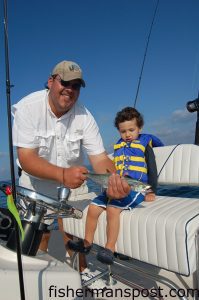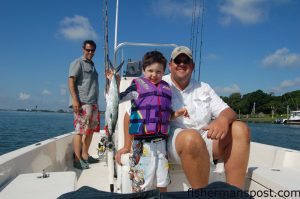Catch A Spanish By The Tail

Capt Russell Weaver, of Living Waters Guide Service, and James Hurley (age 3), son of Fisherman's Post Publisher Gary Hurley, with his first rod-and-reel caught spanish mackerel. He hooked the fish on a pink flash Clarkspoon behind a #1 planer a mile off Wrightsville Beach.
“Keep it steady! Great job! Keep winding! Almost there!” James Hurley heard from three sides as he stood at the gunwale of Capt. Russell Weaver’s 22’ Pathfinder, cranking the handle of a light trolling outfit still in the rod holder.
Russell, who handles the inshore and nearshore trips for Living Waters Guide Service, had agreed to take Gary, myself, and Gary’s boys James (age 3) and Owen (age 4) out for an early morning spanish mackerel excursion while the participants in the 2010 Fisherman’s Post Inshore Challenge plied the June waters in search of money-winning flounder and speckled trout. With slightly more work to do to ensure the event’s weigh-in and awards went off without a hitch, Gary and I definitely had a finite off-the-water time for this trip, and Russell was willing to rise to the challenge of putting the boys on a few spaniards in a very limited window.
“Keep on winding! Steady! Awesome work! I see the planer!” the advice built to a crescendo from the three adults aboard as James’s struggling spanish drew closer to the boat.
James and Owen caught their first spanish a few weeks before on hand lines, but this was their first attempt at cranking them in on a rod-and-reel, and James took to the challenge, silent and focused as he ground away on the reel handle and worked the fish ever closer.
As soon as the planer broke the water’s surface, Russell grabbed the long mono leader and deftly brought the fish aboard.
“James, I think you caught that fish,” his brother added to the cacophony of congratulations now showering down on the youngster.
“I caught a spanish mackerel,” the angler confirmed.
“Do you remember how Daddy told you to hold it?” Gary queried.
“By the tail!” Owen eagerly chimed in. “Hold it by the tail, James.”
After a quick photo session, we were back to setting Russell’s three-line spanish spread and in the hunt for Owen’s first rod-and-reel spanish.
Since the Hurley youths don’t quite understand why anyone would wake up before dawn to go fishing and rise on their own around 7:00 every day, Russell had agreed to pick us up around 8:00 at Wrightsville Beach. The captain, however, hadn’t taken the opportunity to sleep in, going out at dawn to get a handle on where the fish were feeding that morning and maximize our chances for fast success.
It wasn’t a fruitless effort, as Russell explained while we idled though the no-wake zone after getting the boys life-jacketed and secure on both sides of their father on the Pathfinder’s back bench seat.
“They’re hanging between the jetties and the Liberty Ship,” he told us, advancing the throttle to put the boat on an easy plane as we cruised by Bradley Creek.
The boys were immediately fascinated by the waterway scenery, making a point to call out the locations of crab pot floats and channel markers just in case the captain hadn’t taken notice.
After “Captain Russell” explained that wheeling birds often give away the feeding zones of hungry spanish, the boys were on point again. Not a floating pelican, high-flying gull, or one of the swallows flitting about the jetties escaped their sight. They were eager to help out, shouting and pointing each and every time we crossed paths with a winged creature.
Russell kept us moving past the jetties and finally pulled back around 3/4 of a mile off the beach a bit north of the inlet.
After we sent back the rods in his spanish spread—a pink flash Clarkspoon behind a bird, one trailing the aforementioned #1 planer, and a Blue Water Candy Spanish Daisy Chain—Russell hopped back behind the console and bumped up the throttle.
“Now we’re going to pick the speed up to 8 or 9 miles an hour,” he explained, glancing back to make sure everything was laying out smoothly in the Pathfinder’s wake.
“That helps us avoid the bluefish and get the spanish. They’re fast swimmers,” Russell explained to the boys.
Single and occasional pairs of leaping spanish told us that Russell had indeed found the fish that morning, but the bite proved to have slowed down a bit as the sun climbed a little higher.
Capt. Rick Croson, a longtime Fisherman’s Post friend and fellow Living Waters Guide Service captain, heard about our mission and was eager to help put the Hurley boys on some fish. We heard his voice crackle over the radio a short time into our trolling.
“You guys getting them?” he queried, his boat visible in the distance anchored up at the Liberty Ship. “If not, they’re jumping pretty good in the slicks a little bit offshore of you. We just ran through them.”
The advice was much appreciated, but almost as soon as it came a much more sizeable group of spanish broke the surface just at around 1:00, slashing the water and leaping in pursuit of some hapless glass minnows.
“I think we’ll stick around here for a minute,” Russell said, making a slight turn to starboard to trail our lines through the school’s hopeful path.
Not long later, the planer rod was bouncing, the line was angling towards the surface, and we were urging James to get to the rod and bring in his fish.

Owen Hurley and Capt. Russell Weaver, of Living Waters Guide Service demonstrate the proper way to hold a spanish mackerel, as Gary Hurley looks on. The spaniard fell for a pink flash 00 Clarkspoon behind a pink bird teaser a short distance inshore of the Liberty Ship.
After the 3-year-old successfully battled his mackerel to the boat and the flashbulbs died down, the Hurley boys demonstrated the conservation ethic their father had evidently already instilled.
“Now let’s let it go,” they said, cautiously reaching for the fish flopping on deck.
As Gary and I knew we’d be more than flush with fish by day’s end, since all the flounder and trout weighed in at the Inshore Challenge become property of the tournament (I’m still working on some of the flounder), we’d certainly have agreed, but Russell had other plans.
Since he would be fishing the Big Rock Blue Marlin Tournament the following week aboard the boat “Jolly Mon,” today’s spanish had a future destiny with large circle hooks, and Russell tossed it in the Pathfinder’s fish box as Gary introduced the idea to the boys.
“Capt. Russell likes that for a bait. He’s going to try and catch a bigger fish and win a million dollars with it,” Gary explained to the wide-eyed youths while the hunt for Owen’s spaniard now began.
Again, we had to search a bit for a bite, leading Owen to hop up on the leaning post and begin rapid-firing questions about the many buttons and other protrusions from the console.
“What’s this?” he said. I followed his mischievous glance to the 250 hp Yamaha’s throttle.
“That’s the throttle,” I explained, grinning,. “Probably something we shouldn’t touch right now.”
“No button-pushing, Owen,” Gary added. “You can ask Russell about the buttons when we get back to the waterway.”
Owen’s curiosity soon found a new focus, and he leapt off the leaning post to point into the water.
“Jellyfish!” he squealed, and he and James were soon captivated and pointing out each one that the boat crossed over.
We’d pulled offshore a bit toward the Liberty Ship, and as I followed the children’s outstretched arms, I noticed we’d come across quite a collection of jellies, and not the innocuous cannonball sorts usually around. These were flattened and clear, bearing a set of red tentacles that would no doubt leave a mark were they to brush against one’s skin. I also mentally noted how fascinated I’d have been with the near-alien life forms at Owen and James’s age.
“There he is!” Russell exclaimed, jarring my gaze from the water to see that the rod bearing the bird rig was now bouncing under the protests of a feisty spanish mackerel.
After a quick shuffle with the planer rod to get the bird rig into the starboard holder where Owen could reach the handle, the older Hurley brother got cranking.
“You own that fish, Owen! Steady, steady. Now show me your fast wind!” Gary urged while the 4-year-old cranked away, looking determined. “Great job!”
As with James’s fish, the mood only swelled as the bird drew closer and closer to the boat and the three of us implored him to keep going.
“Just a few more turns. Here comes the bird!” Russell added as he reached out, seized the splashy pink teaser and began hand-lining the spanish in.
Russell fishes a 25’ leader on his bird rigs, so the kids had a few moments to get excited while he hauled the mackerel to and over the transom. Mission accomplished: each child had a spanish and we still had time to pull off Inshore Challenge setup.
With the fish in the boat and time running short, we headed inshore, pausing for a picture in the ICW.
Owen proudly held his fish for the camera, and then we slid the future marlin bait next to its companion in the box. Russell then made a special offer, “Owen, do you want to work the throttle?”
The word had barely escaped the captain’s lips by the time the throttle went from neutral to the dash. Catching myself with a lucky grab on the console rail, it occurred to me that I’ve never quite realized the speed and power of a 250 hp 22’ Pathfinder before.
After we’d caught our balance and explained the need for a bit of subtlety in the use of a boat throttle, Owen again took the gas, this time easing us gently on plane just in time to slow down for the no-wake zone.
Russell’s patience and a natural teacher’s instinct coupled with an obvious ability to find and hook fish make him an ideal captain for a trip with children, even young ones. In addition to spanish mackerel, he pursues the gamut of inshore and nearshore species, and finds time for nearly every type of offshore fishing our area’s got to offer as well.
To schedule a trip with Russell or learn more about Living Waters Guide Service, give him a call at (919) 749-3186 or go online to www.livingwatersguide.com.
